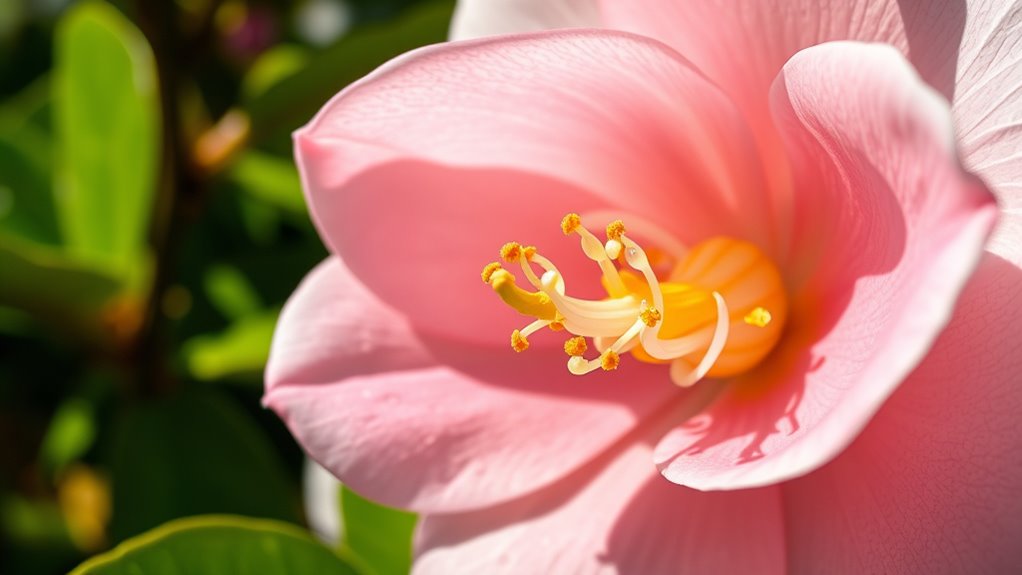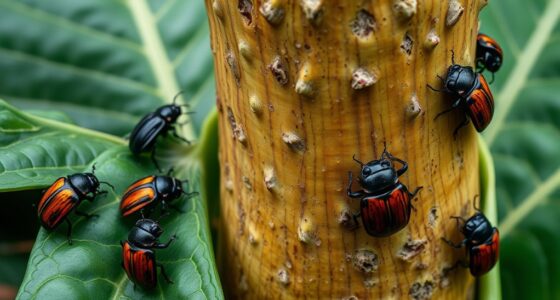If you’re curious about the rarest camellia, you’ll find the Camellia Azalea fascinating. This plant blooms during the hottest part of summer, unlike most camellias that prefer cooler seasons. Its delicate, colorful flowers appear in clusters, adding striking beauty when few other plants are in bloom. Its unique timing makes it a prized garden feature and collector’s item. Explore further to discover how this extraordinary shrub can enhance your outdoor space with its stunning summer display.
Key Takeaways
- Camellia azalea blooms during summer, unlike most camellias that flower in cooler months.
- Its delicate, ruffled petals resemble azaleas and come in pink, red, and orange hues.
- Prefers well-drained, acidic soil with partial shade; requires regular watering and protection from extreme heat.
- Rarely available in nurseries, making it a prized collector’s plant for its unique summer flowering.
- Its vibrant summer display adds unexpected color and interest, highlighting nature’s diversity and adaptability.

Have you ever wondered how some plants burst into vibrant color just when summer reaches its peak? One such marvel is the Camellia Azalea’s summer bloom, a rare sight that captures the attention of gardeners and plant enthusiasts alike. Unlike most camellias that flourish in cooler months, this unique variety flowers during the hottest part of the year, creating a stunning contrast to the typical summer landscape. Its unexpected burst of color is a proof to nature’s diversity and adaptability, making it a prized addition to any garden aiming for year-round interest.
Discover the rare and vibrant summer bloom of the Camellia Azalea, adding unexpected color to your garden during peak heat.
The Camellia Azalea’s summer bloom is an extraordinary variation of the traditional camellia, often mistaken for an azalea because of its delicate, ruffled petals and vibrant hues. This plant has adapted to bloom in the heat, thanks to specific genetic traits and cultivation techniques that allow it to thrive in warmer climates. Its flowers range from soft pinks to fiery reds, often with a hint of orange, and bloom in clusters that cover the shrub’s foliage. These blooms not only add a splash of color but also attract pollinators like bees and butterflies during a time when many other plants are past their prime. This natural timing advantage makes the Camellia Azalea especially valuable for creating a dynamic, lively summer garden.
Growing this rare plant requires some attention to detail. It prefers well-drained, slightly acidic soil and benefits from partial shade during the hottest hours of the day. While it’s relatively hardy once established, it’s vital to protect it from extreme heat or drought conditions that can stress the plant and hinder flowering. Regular watering, mulching, and occasional fertilization help maintain its health and encourage robust blooming. Because it blooms in summer, you’ll want to plant it in a location that gets morning sun and afternoon shade, giving it the best chance to produce those spectacular flowers. Pruning after flowering helps shape the shrub and promotes healthy growth for the next season.
What truly sets the Camellia Azalea apart is its rarity. Not many gardeners are aware of this summer-blooming camellia, and finding one can be a challenge. Its unique blooming schedule and striking appearance make it a conversation piece and a valuable collector’s item for specialty nurseries. If you’re lucky enough to add one to your garden, you’ll enjoy a rare spectacle of color in the midst of summer’s heat, bringing a touch of elegance and surprise to your outdoor space. This plant reminds us that nature’s variety extends beyond what we typically expect, offering a beautiful, unexpected gift when you least anticipate it.
Frequently Asked Questions
When Is the Best Time to Plant Camellia Azalea?
You should plant your camellia azalea in early spring or fall when the weather is cool and moist. Avoid planting during the hot summer or freezing winter months to guarantee healthy growth. Pick a shaded spot with well-draining, acidic soil. Before planting, prepare the soil by adding organic matter. Water thoroughly after planting, and keep the soil consistently moist, especially during dry periods, to help your camellia thrive.
How Often Should I Water Camellia Azalea During Summer?
You should water your camellia azalea deeply twice a week during summer, but don’t overdo it—too much water can harm the roots. Keep the soil consistently moist but not soggy, especially during high heat. As the temperature rises, check frequently to see if the top inch of soil feels dry; if it does, it’s time to water again. Stay vigilant, and your plant will reward you with vibrant blooms.
Can Camellia Azalea Thrive in Containers or Pots?
Yes, you can grow a camellia azalea in containers or pots. Make certain you choose a well-draining pot with enough space for roots to grow. Use acidic, organic soil and water regularly to keep the soil moist but not soggy. Place the container in a location with partial shade, and consider fertilizing during the growing season. With proper care, your container camellia azalea will thrive and produce beautiful blooms.
What Pests Are Common on Camellia Azalea?
You’ll often find pests like aphids, scale insects, and spider mites on your camellia azalea. These pests suck sap from the plant, leading to yellowing leaves and stunted growth. Regularly inspect your plant, especially the undersides of leaves, and use insecticidal soap or neem oil to manage infestations. Keeping your plant healthy through proper watering and pruning also helps prevent pest problems.
How Do I Protect Camellia Azalea From Extreme Heat?
To protect your camellia azalea from extreme heat, you should provide it with shade during the hottest part of the day, ideally with a shade cloth or strategic planting. Keep the soil consistently moist but not waterlogged, and mulch around the base to retain moisture and regulate soil temperature. Additionally, avoid fertilizing during peak heat to prevent stress, and water early in the morning for ideal absorption.
Conclusion
Now that you know about Camellia Azalea’s rare summer bloom, you can appreciate its fleeting beauty like a precious secret whispered by nature. This delicate flower reminds us that life’s most extraordinary moments often bloom when we least expect them. Cherish these rare treasures, for they’re reminders to find wonder in the unexpected. Like a fleeting sunset, its bloom sparks a sense of awe—an invitation to treasure each magical, fleeting moment life offers.










